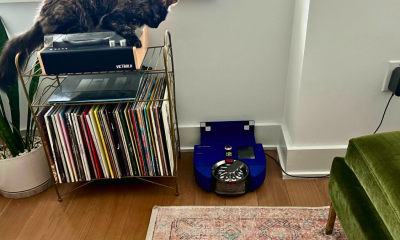Entertainment
Shadows Die Twice’ and difficulty vs. accessibility

For anyone who’s been paying attention to the social media discourse around video games in recent days, you’ve probably noticed a couple of frequently repeated buzzwords.
There’s “difficulty” and “accessibility,” and lots of discussion around the tension between those two concepts. There’s also “Sekiro” and “FromSoft,” a reference to the newly released game Sekiro: Shadows Die Twice from Dark Souls and Bloodborne developer From Software.
I’ll be the first one to admit that the discourse around video games online can sometimes come across as unapproachable to a wider audience. But I also think this particular example is well worth taking the time to understand, so let’s dive in.
What is this game?

Sekiro is a game where you play as a ninja in a fantasy world version of feudal Japan. You’ve got a big sword, a mechanical arm, and a bag of tricks to pull from as you hack-and-slash your way through an army of foes.
From Software games are known for their high levels of technical challenge, and Sekiro is no exception. Instead of using sword chops to whittle away at each enemy’s health, you’re slowly degrading their posture — their ability to fend off your attacks, basically — while maintaining your own. Break their posture and you earn yourself an opening to deliver a quick showstopper of a killing blow.
In practice, Sekiro battles are a deadly dance. You’re reading every frame and watching for the slightest giveaway moment as you circle a foe. There are different audio cues and visual cues that you pick up with time and experience, and therein lies the game: keep throwing yourself at a threat until you learn its behaviors, then use that knowledge to overcome it.
The high degree of challenge lies in the details. Enemies move swiftly and without any reliable pattern. They appear in different groupings, or are tucked just out of sight until you cross some invisible line. Bosses and minibosses, Sekiro‘s greatest tests, demonstrate a wider variety of moves and strike harder in general.
I’ve been playing games both personally and professionally for a very long time. Sekiro is by far the most challenging one I’ve ever played. I doubt I’ll ever find the time to master it, or even finish. Lots of people have reached a similar conclusion, and that’s perfectly OK.
So what’s all the fuss about?

Sometime after Sekiro released on March 22, people started suggesting that maybe From Software could lighten up a bit. Where games like Dark Souls and Bloodborne gave players the option of slowly increasing their power until steep threats became more manageable, Sekiro doesn’t do the RPG-style leveling thing in quite the same way.
What’s more, Sekiro isn’t online at all. In past From games, an online connection opened up access to a number of benefits, including helpful, player-scrawled notes and, more importantly, the ability to summon outside help. A total stranger could hop into you game at most times and, yes, choose to screw up your day. But they could also help, and be helped in return. Even the hardest bosses become trivial when it’s 2v1.
Sekiro ditches all of that. There’s no online play. There’s no power-based leveling. This is a game without any kind of safety valve. You either come to grips with mastering it… or you don’t. And if you don’t, well… there’s a whole lot of beautiful, thought-provoking game you’re missing out on.
From games don’t do “easy” difficulty settings — or any kind of adjustable difficulty — by design, but Sekiro ditches all pretense: there’s no help to be found. Though as many have pointed out, “easy” is a relative concept.
“I myself deal with occasional chronic pain that’s only alleviated by a brace. When I put it on, I am ten percent clumsier with a controller, making Sekiro ten percent harder. Can I rise to meet that extra ten percent? Maybe. Should I be expected to? That’s a different question,” Joshua Rivera wrote for Kotaku in a post arguing that an “easy mode” has never ruined a game.
Rivera continued: “Some people with disabilities may not need adjustments, but that’s exactly the point: ‘Hard’ means different things to different people.”
Difficulty vs. accessibility

This is where we come to the heart of the conversation around Sekiro. There’s a faction of From Software diehards who resist any suggestion that the game could be made more welcoming for a wider audience. They claim such a move would torpedo From’s artistic intent, as evidenced by the studio’s past games and general philosophy around what constitutes challenging gameplay.
But that’s not quite right. Whether those fans truly believe in the importance of preserving From’s “artistic intent” or they’re just (subconsciously or not) gatekeeping their “for elite players only!” game, they’re forgetting that difficulty is subjective. Interpretations of what “hard” means vary wildly, especially when you accept that not every player possesses the same physical or cognitive skills.
Besides, all of those “but artistic intent!” arguments overlook another core fact about video games: there’s something exciting, even rewarding, about breaking the rules as they are written. As Waypoint’s Patrick Klepek argued, longtime gamers aren’t exactly strangers to this idea.
People have always sought different ways to play a game, and we hypocritically conflate the terms “easy,” “effective,” and “fun” with whatever makes us situationally look better. Players used to hold their PSPs in weird ways, a method called the “claw,” in order to control Monster Hunter’s camera correctly. Capcom probably didn’t plan for that! Cheat Engine, essentially a modern day Game Genie, is a piece of software entirely devoted to letting you, well, cheat. Every person has a story where they glitched through a wall, or watched a boss glitch to their death, and celebrated that advancement as canon.
He points to an even wider range of examples than that, from classic cheats like the Konami Code — which made Contra (among others) much more approachable for all players back in the day — to modern examples of “cheesing,” or using blind spots in a game’s code or AI programming to claim some kind of advantage.
So, difficulty is subjective. It’s ultimately a function of design and is based on how a game’s creator perceives the audience. Accessibility is a different consideration entirely. It is, as “accessibility, inclusion and diversity advocate” Cherry Thompson wrote for IGN, about recognizing barriers.
Games are, at their core, a set of barriers arranged to create a challenge, mixed with the illusion that you’re solving it all yourself. There are times, however, where developers might have created barriers we don’t realize are there. It’s why we playtest, and it’s how we end up accidentally excluding players, especially disabled players, who we’d like to include. We deliberately mitigate and remove barriers all the time in the course of game design (Sekiro does this through its frequent checkpoint idols and the stealth indicators, for example) but if we don’t design and test with the full spectrum of our player base in mind, we’ll inevitably have unintentional barriers.
Accessibility is about removing or mitigating those unintentional barriers. The obstacles that spring up and prevent a chunk of the audience from enjoying the game on the same level as the target crowd.
Thompson’s feature discusses the various improvements From Software has made on the accessibility front over the years. Discrete volume sliders, larger on screen text, and the ability to remap control schemes have all made the studio’s various games more approachable without sacrificing the emphasis on technical skill — which is to say, mastering the controls and mechanics — that is central to every encounter in a From game.
But, she adds, that doesn’t mean there isn’t room for improvement. That’s really the crux of all the discussion around accessibility in the wake of Sekiro‘s release: for all the angry “git gud” players, as Klepek calls them — the people expressing concern that a more accessible Sekiro represents a betrayal of From’s central focus — they’re missing the point.
Steve Spohn, COO of the AbleGamers charity, summed it up quite well in a Friday thread on Twitter.
In any game, whether it’s Sekiro, Dark Souls, or any other skill-based game, there should be options to allow your health to be modified, your enemies help to be modified, and the game speed adjusted.
This does not make the game easy. It allows people to make the game equal
— Steve Spohn (@stevenspohn) April 5, 2019
Nobody is advocating that we take your favorite game that is famous for being frustratingly difficult and make it so easy nobody cares.
The only request on the table is to allow people who cannot “git gud” by learning, to have the options to make the game playable
— Steve Spohn (@stevenspohn) April 5, 2019
It’s not like this is a new conversation. There are fresh examples every day of games making strides and getting accessibility right. As Thompson pointed out, even creative teams like From that embrace a certain dogmatic attitude toward difficulty have shown the capacity to grow and improve.
But there’s always room for improvement, even as there are plenty of creators out there that get it. I’m here laying all of this out because I think the community should be an equal participant in reminding creators that difficulty is relative and wholly removed from making games accessible for every kind of player.

-

 Business4 days ago
Business4 days agoAPI startup Noname Security nears $500M deal to sell itself to Akamai
-

 Business7 days ago
Business7 days agoYoshi Mobility has come a long way since gassing up cars on the side of the road
-

 Entertainment4 days ago
Entertainment4 days agoHow to watch ‘Argylle’: When and where is it streaming?
-

 Entertainment4 days ago
Entertainment4 days agoNASA discovered bacteria that wouldn’t die. Now it’s boosting sunscreen.
-

 Business4 days ago
Business4 days agoUS think tank Heritage Foundation hit by cyberattack
-

 Entertainment4 days ago
Entertainment4 days agoDyson 360 Vis Nav robot vacuum review: Dyson should just stick to upright vacuums
-

 Business3 days ago
Business3 days agoTesla drops prices, Meta confirms Llama 3 release, and Apple allows emulators in the App Store
-

 Entertainment4 days ago
Entertainment4 days agoCrypto and taxes: Which forms you need to file



















